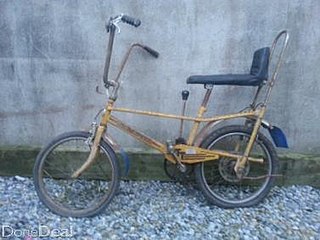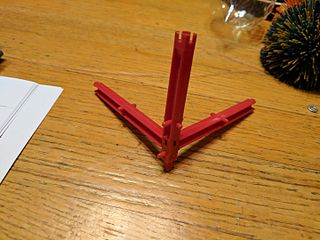
A tie rod or tie bar is a slender structural unit used as a tie and capable of carrying tensile loads only. It is any rod or bar-shaped structural member designed to prevent the separation of two parts, as in a vehicle.
Meccano is a brand of model construction system created in 1898 by Frank Hornby in Liverpool, England. The system consists of reusable metal strips, plates, angle girders, wheels, axles and gears, and plastic parts that are connected using nuts and bolts. It enables the building of working models and mechanical devices.

The A. C. Gilbert Company was an American toy company, once one of the largest in the world. Gilbert originated the Erector Set, which is a construction toy similar to Meccano in the rest of the world, and made chemistry sets, microscope kits, and a line of inexpensive reflector telescopes. In 1938, Gilbert purchased the American Flyer, a manufacturer of toy trains. The Gilbert Company struggled after the death of its founder in 1961 and went out of business in 1967. Its trademarks and toy lines were sold to other companies.

American Flyer is a brand of toy train and model railroad, originally manufactured in the United States.
Dinky Toys was the brand name for a range of die-cast zamak zinc alloy scale model vehicles, traffic lights, and road signs produced by British toy company Meccano Ltd. They were made in England from 1934 to 1979, at a factory in Binns Road in Liverpool.

Hornby Hobbies Limited is a British-owned scale model manufacturing company which has been focused on model railways. Its roots date back to 1901 in Liverpool, when founder Frank Hornby received a patent for his Meccano construction toy. The first clockwork train was produced in 1920. In 1938, Hornby launched its first OO gauge train. In 1964, Hornby and Meccano were bought by their competitor, Tri-ang Railways, and sold when Tri-ang went into receivership. Hornby Railways became independent again in the 1980s, and became listed on the London Stock Exchange, but due to financial troubles reported in June 2017, became majority owned by British turnaround specialist Phoenix Asset Management.

Alfred Carlton Gilbert was an American inventor, athlete, magician, toy maker and businessman. As the founder of A. C. Gilbert Company, Gilbert was known for inventing the Erector Set and American Flyer Trains.

K'Nex is a construction toy system created by Joel Glickman. It was first introduced in America in 1992. K'Nex is designed and produced by K'Nex Industries Inc. of Hatfield, Pennsylvania. K'Nex was purchased by Florida-based company Basic Fun! in 2018.
Frank Hornby was an English inventor, businessman and politician. He was a visionary in toy development and manufacture, and although he had no formal engineering training, he was responsible for the invention and production of three of the most popular lines of toys based on engineering principles in the 20th century: Meccano, Hornby Model Railways and Dinky Toys. He also founded the British toy company Meccano Ltd in 1908, and launched a monthly publication, Meccano Magazine in 1916.
Meccano Ltd was a British toy manufacturing company, established in 1908 by Frank Hornby in Liverpool, England, to manufacture and distribute Meccano and other model toys and kits created by the company. During the 1920s and 1930s it became the biggest toy manufacturer in the United Kingdom and produced three of the most popular lines of toys in the twentieth century: Meccano, Hornby Trains and Dinky Toys.
British Standard Whitworth (BSW) is an imperial-unit-based screw thread standard, devised and specified by Joseph Whitworth in 1841 and later adopted as a British Standard. It was the world's first national screw thread standard, and is the basis for many other standards, such as BSF, BSP, BSCon, and BSCopper.

Lines Bros Ltd was a British toy manufacturer of the 20th century, operating under the Tri-ang Toys brand name.

Mamod was a toy manufacturer that was based in Britain that specialized in producing live steam Models until closure in 2024. The company was founded in Birmingham in 1937 by Geoffrey Malins. The name "Mamod" is a combination of "Malins Models." Initially, the company manufactured stationary steam engines, which were originally sold under the 'Hobbies' brand. Subsequently, Malins introduced the brand name 'Mamod.'

A girder is a beam used in construction. It is the main horizontal support of a structure which supports smaller beams. Girders often have an I-beam cross section composed of two load-bearing flanges separated by a stabilizing web, but may also have a box shape, Z shape, or other forms. Girders are commonly used to build bridges.
Bayko was a British building model construction toy invented by Charles Plimpton, an early plastics engineer and entrepreneur in Liverpool. First marketed in Britain it was soon exported throughout the British Commonwealth and became a worldwide brand between 1934 and 1967. The name derived from Bakelite, one of the world's first commercial plastics that was originally used to manufacture many of the parts. Bayko was one of the world's earliest plastic toys to be marketed.

Merkur refers to a metal construction set built in Czechoslovakia. It was also referred to as Constructo or Build-O in English-speaking countries and Tecc in the Netherlands.

Girder and Panel Building Sets were a series of plastic toy construction kits created by Kenner Toys in the mid-1950s. Since then, the building sets have gone in and out of production several times, under a succession of different owners of the designs.

Educational toys are objects of play, generally designed for children, which are expected to stimulate learning. They are often intended to meet an educational purpose such as helping a child develop a particular skill or teaching a child about a particular subject. They often simplify, miniaturize, or even model activities and objects used by adults.

An ironworker is a tradesman who works in the iron-working industry. Ironworkers assemble the structural framework in accordance with engineered drawings and install the metal support pieces for new buildings. They also repair and renovate old structures using reinforced concrete and steel. Ironworkers may work on factories, steel mills, and utility plants.
Zinc flake coatings are non-electrolytically applied coatings, which provide good protection against corrosion. These coatings consist of a mixture of zinc and aluminium flakes, which are bonded together by an inorganic matrix.
















